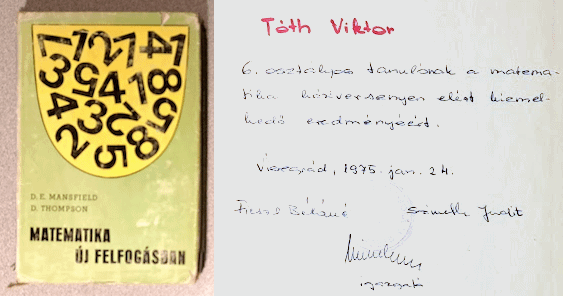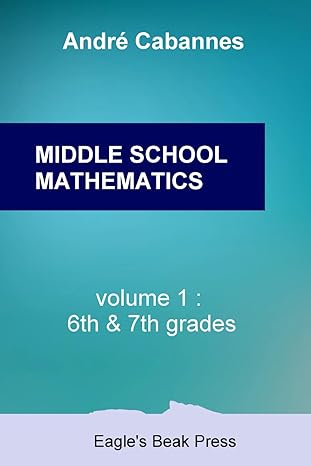Here is one of my cherished possessions. A book, with an inscription:

The inscription, written just over 50 years ago, explains that I received this book from my grade school, in recognition for my exceptional results in mathematics as a sixth grade student. (If memory serves me right, this was the year when I unofficially won the Pest county math championship… for eighth graders.)
The book is a Hungarian-language translation of a British volume from the series Mathematics: A New Approach, by D. E. Mansfield and others, published originally in the early 1960s. I passionately loved this book. It was from this book that I first became familiar with many concepts in trigonometry, matrix algebra, and other topics.
Why am I mentioning this volume? Because the other day, the mailman arrived with an Amazon box containing a set of books. A brand new set of books, published in 2024. A series of mathematics textbooks for middle school and high school students, starting with this volume for 6th and 7th graders:
My instant impression: As a young math geek 50 years ago, I would have fallen in love with these books.
The author, André Cabannes, is known, among other things, as Leonard Susskind’s co-author of General Relativity, the latest book in Susskind’s celebrated Theoretical Minimum series. Cabannes also published several books in his native French, along with numerous translations.
His Middle School Mathematics and High School Mathematics books are clearly the works of passion by a talented, knowledgeable, dedicated author. The moment I opened the first volume, I felt a sense of familiarity. I sensed the same clarity, same organization, and the same quality of writing that characterized those Mansfield books all those years ago.
Make no mistake about it, just like the Mansfield books, these books by Cabannes are ambitious. The subjects covered in these volumes go well beyond, I suspect, the mathematics curricula of most middle schools or high schools around the world. So what’s wrong with that, I ask? A talented young student would be delighted, not intimidated, by the wealth of subjects that are covered in the books. The style is sufficiently light-hearted, with relevant illustrations on nearly every page, with the occasional historical tidbit or anecdote, making it easier to absorb the material. And throughout, there is an understanding of the practical nature, utility of mathematics, that is best summarized by the words on the books’ back cover: “Mathematics is not a collection of puzzles or riddles designed to test your intelligence; it is a language for describing and interacting with the world.“
Indeed it is. And these books are true to the author’s words. The subjects may range from the volume of milk cartons through the ratio of ingredients in a cake recipe all the way to the share of the popular vote in the 2024 US presidential election. In each of these examples, the practical utility of numbers and mathematical methods is emphasized. At the same time, the books feel decidedly “old school” but in a good sense: there is no sign of any of the recent fads in mathematics education. The books are “hard core”: ideas and methods are presented in a straightforward way, fulfilling the purpose of passing on the accumulated knowledge of generations to the young reader even as motivations and practical utility are often emphasized.
This is how my love affair with math began when I was a young student, all those years ago. The books that came into my possession, courtesy of both my parents and my teachers, were of a similar nature: they offered robust knowledge, practical utility, clear motivation. Had it existed already, this wonderful series by Cabannes would have made a perfect addition to my little library 50 years ago.

Despite my curiosity for math I never was good at it. Thus it happened that my math-related books from childhood were just of the kind mentioned above as “collections of puzzles or riddles” (or curiosities). But perhaps you also had perused such books in very childhood – those targeted to lower grades or even pre-school. BTW among them was one, in the same series as M.Gardner’s collections, one from Hungarian authors “Bizam, Herczeg – Sokszinu Logika”, translated of course. I don’t think I learnt much of logic (above what I already knew by then) from it – but it was nice in bringing along with puzzles a “national flavor” – names, geographical comments (e.g. Budapest consists of Buda and Pest divided by Duna etc) for which it was perhaps more interesting to me than for its somewhat childish logic exercises.
Heh. Never saw that book before. But yes, growing up in Budapest, one of the first things you learn, probably still in kindergarten, is how the city was formed by uniting Pest and Buda (and “old Buda” — Óbuda) in 1873 and how quickly that city became a world class metropolis (e.g., sporting the continent’s first — the world’s second — all-electric subway system by 1896, or the famous Telephone Herald, the wired predecessor of broadcast radio, also by the mid-1890s). The city has a rich history… unfortunately, not always a happy story.